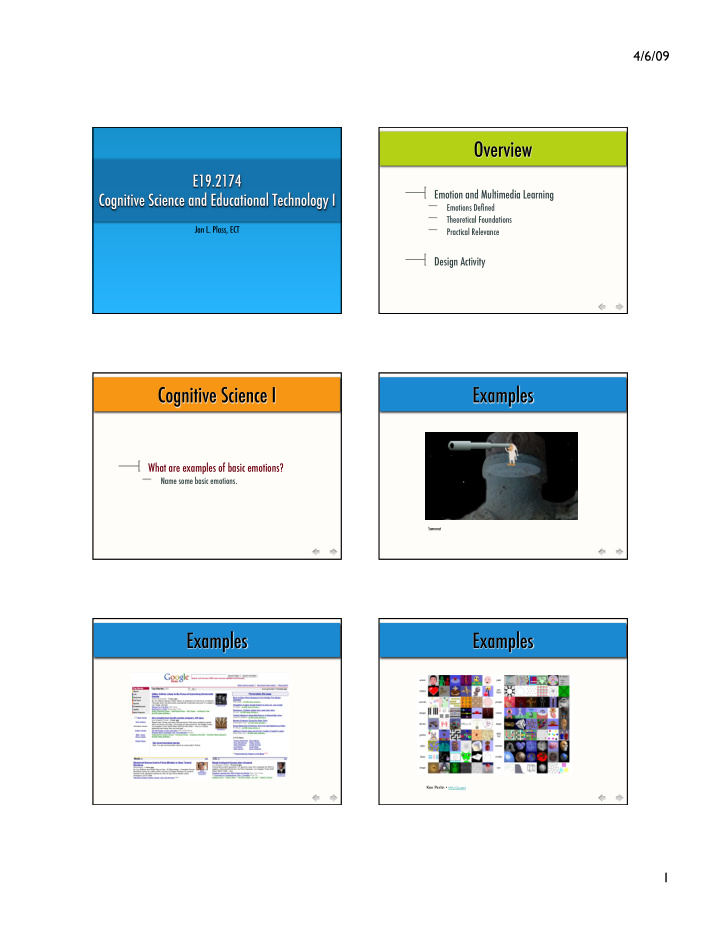



4/6/09 Emotion and Multimedia Learning � Emotions Defined � Theoretical Foundations � Jan L. Plass, ECT � Practical Relevance � Design Activity � What are examples of basic emotions? � Name some basic emotions. � Samorost � Ken Perlin • NYU Courant 1
4/6/09 Club Marian • Maid Marian Emotions � Acceptance Affection Aggression Ambivalence Anger Apathy Anxiety Compassion Depression Disgust Doubt Ecstasy Empathy Envy Embarrassment Euphoria Fear Forgiveness Frustration Guilt Gratitude Grief Happiness Hatred Hope Horror Hostility Homesickness Hysteria Loneliness Love Paranoia Pity Pleasure Pride Rage Regret Remorse Sadness Shame Suffering Surprise Sympathy � Seven basic emotions � fear (or terror, shock, phobia) � anger (or rage, directed to the self or others) � sorrow (or sadness, or grief or depression) � Emotions Defined � joy (happiness, glee, gladness). � disgust � acceptance � anticipation � surprise � 2
4/6/09 Evolutionary Perspective Emotions: based in evolution, serve essential biological and social functions � Emotions Defined � Evolutionary Perspective � Physiological Perspective � Cognitive Perspective � Physiological Perspective � Physiological Perspective � Emotions: result of a ‘bodily change’ that results in physiological arousal � Emotions: generated by people’s judgement about the world, � initiated by an individual’s appraisal of his or her circumstances � (Frijda, 1993; Lazarus, 1991; Oatley & Johnson-Laird, 1987) � Emotions � Psychiatry: "mood" routinely used to denote states of happiness and sadness and their extremes � Emotions: person's mental state of being, normally based in or tied to the person's internal (physical) and external (social) sensory feeling � Emotion is the conscious experience of affect, with attribution of cause and identification of its object � Desmet & Hekkert • Source 3
4/6/09 Levels of Emotions (Norman, 2003) � Visceral � Appearance, physical features of the material � => instant and rapid judgments � Behavioral � Pleasure and effectiveness of use by providing interactions between the user and the material � Reflective � Deals with self-image, personal satisfaction, and memories, which come from the conscious reflection and experience including knowledge, learning and culture � Circumplex model of core affect with product relevant emotions • Desmet & Heckert, 2005, adopted from Russell. 1980 Practical Relevance � Emotions are inseparable from and necessary part of What practical relevance does emotion have for cognition � Emotions affect cognition � instructional designers? � Cognition affects learning � Mood-dependent retrieval � Mood-congruent processing � Mood-dependent retrieval � Mood-congruent processing � 4
4/6/09 Facilitation Hypothesis � Emotions broaden available cognitive resources � How do emotions affect learning? � Positive emotions help long-term memory and retrieval (e.g., Erez & Isen, 2002; Weiss, Nicholas, & Daus, 1999) � Facilitation Hypothesis � Learners experiencing positive emotions interpret situations more positively than they would at other times, making more positive Cognitive Load Hypothesis � judgments and give more favorable feedback (Isen, Shalker, Clark, & Karp, 1978; Isen & Patrick, 1983; Petty et al., 1993; Weiss et al., 1999) � => Learning increases � Suppression (Cognitive Load) Hypothesis � How would you determine whether the Emotions compete with cognition for available cognitive resources, facilitation hypothesis or the cognitive load i.e., emotions increase extraneous cognitive load � Coherence Principle: Remove interesting but irrelevant facts � hypothesis applies to your materials? � (Harp & Mayer, 1997, 1998; Moreno & Mayer, 2000) � => Learning decreases � Example � How are emotions induced? � Externally, before learning materials � Internally, as part of the learning materials � 5
4/6/09 Example � How can visual design affect emotion? � Comparison of different visual designs � Variation of hue, saturation, lightness � Use of “baby face bias” (Lorenz & Generale, 1950) � Use of Anthropomorphism effect (Dehn & Van Mulken, 2000) � Study with 116 NYU graduate students: � The design of visual materials can affect emotions positively, resulting in better learning (Um & Plass, 2007) � Control affects learning with animations (Hasler, Kersten, & Sweller, 2007) � The a fg ective background circle, showing how the colours, shapes and sizes of objects vary together with Russell’s circumplex model of a fg ect (Fagerberg et al., 2004) � The affective gestural plane model (Fagerberg et al., 2004) � The tangible interface–expressing emotions through gestures (Fagerberg et al., 2004) � 6
4/6/09 Emotional Design Task � Design an interface for a learning tool that uses elements of emotional design to increase learning: � Emotions in ID � Define which hypothesis will apply to your situation, � Decide what emotions you plan to affect � Decide how you will affect emotions � Describe how you would test whether your plan has worked. � 7
Recommend
More recommend